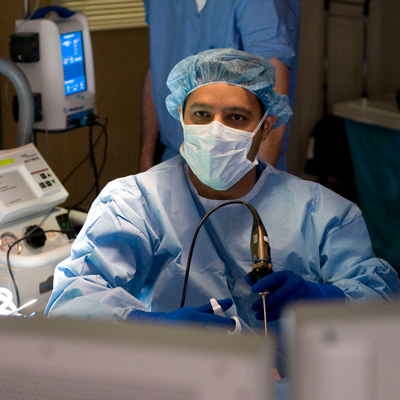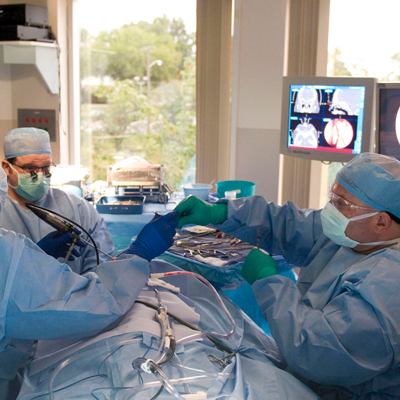Overview
About Your Sinuses
Your sinuses are hollow air spaces within the bones between your eyes, and behind your cheeks and forehead that are connected to the nose by narrow channels. These four pairs of sinuses produce thin mucus that drains out of the channels from the nose.
When your sinuses can’t drain, you often feel pain or pressure, and are at a much higher risk of sinus infections. Not only are sinus problems uncomfortable, they can have a significant impact on your overall health and quality of life.
Chronic Sinusitis

Sinusitis is an inflammation of the paranasal sinuses located near your nose. When this condition lasts for more than three months, it is called chronic rhinosinusitis (CRS).
The causes of CRS are poorly understood. Symptoms include facial congestion/fullness, nasal obstruction (blockage), pus in the nasal cavity, fever and nasal discharge/discolored postnasal drainage. Additional symptoms may include headaches, bad breath, fatigue, dental pain and cough.
To diagnose CRS, your doctor will discuss your symptoms and examine your face for swelling and tenderness over the cheekbone area. During the exam, the doctor will look into your nose to inspect the lining for signs of inflammation and active infection. Usually, the actual sinus drainage channels are very closely examined using a painless procedure known as nasal endoscopy. During this procedure, the nasal passages are decongested with a spray, and a fine telescope equipped with a camera is gently advanced into the nose and the sinus channels are directly viewed for signs of pus, mucus or the presence of polyps. Other diagnostic tests may include a study of the mucus culture, allergy testing or a CT scan of the sinuses.
Treatment for chronic sinusitis may include using a vaporizer and/or warm compresses to alleviate congestion, saline irrigations, nasal steroid sprays that shrink swollen membranes, oral decongestant, antibiotics (for bacterial infections only) and steroid medications. Allergies should be controlled and irritants, such as smoke, should be avoided. If antibiotics and other medicines are not effective in opening the sinuses and clearing the infection, surgery (done on an outpatient basis, not requiring a hospital stay) may be necessary to remove the blockage and to re-establish healthy functioning of the sinuses.
Chronic sinusitis with nasal polyps
Sometimes chronic sinusitis is accompanied by noncancerous growths, called polyps. These polyps grow in the nose like bunches of grapes and can block the flow of mucus out of the sinuses, leading to persistent or recurrent sinus infections. They also can block odors from reaching the organ of smell high up in the nose and lead to a decreased sensation of smell, and physically block the nasal passages causing nasal congestion/blockage.
Medications may be used to shrink or get rid of polyps, but outpatient surgery often is needed to remove them. Polyps often tend to reoccur, requiring additional treatments after surgery.
Deviated Septum

When a patient has a deviated nasal septum, the septum in the nasal cavity leans to the right or the left. Symptoms may include difficulty breathing through one or both nostrils, nasal congestion, headaches, bloody noses, snoring or sleep apnea. Sinus drainage also can be compromised if the deviation is severe. However, not all patients with a deviated septum have symptoms.
Diagnosis is made by physical examination of your nose. This involves using a nasal speculum to gently separate the nostrils and a bright light to examine the inside of the nose and septum. Often a nasal endoscopy is performed to closely examine the septum and to rule out other causes of nasal blockage, such as chronic sinusitis or nasal polyps.
When medical therapy using nasal steroid sprays, etc. do not offer adequate relief, surgical correction can offer excellent results. The procedure is typically done on an outpatient basis under general anesthesia. Patients may initially have increased nasal obstruction (blockage) after surgery for a short while that improves gradually during the next several days. This is due to swelling that occurs during surgery. Our rhinologists rarely use nasal packing after this or any type of sinus or nasal surgery.
Understanding nasal obstruction Nasal obstruction simply means you can’t breathe normally through one or both sides of the nose due to a blockage of some type. Not only is this symptom uncomfortable, but it may cause problems with eating, sleeping, and predispose you to sinus infections. There are many causes of nasal obstruction, including:- The common cold
- Allergies
- Nasal polyps
- A deviated septum
- Inferior turbinate hypertrophy
- Allergic rhinitis
Talk to your doctor to find out the cause of your symptoms and the most appropriate treatment for you.
Inferior Turbinate Hypertrophy
Turbinates are normal bony structures found inside your nose, which are covered by mucosal lining. The inferior, or the lowest-positioned pair of turbinates, help to humidify, heat and filter air. Inferior turbinate hypertrophy is a condition in which they become swollen due to allergy or dust irritation, having a deviated septum, or other sinus-related medical conditions.
This swelling usually causes nasal congestion and difficulty breathing. The condition can be diagnosed by a medical history and physical exam, including nasal endoscopy.
Treatment may include nasal steroid sprays, antihistamine sprays or oral medication. If these medications do not help reduce the turbinates or adequately control the symptoms, surgery may be recommended. There are a number of procedures available, including those to reduce the size of the turbinates as well as using radiofrequency ablation or heat to shrink the turbinates. Often a deviation of the septum also is present and both issues can be addressed at the same time. Your surgeon will discuss which option is best for you.
Allergic Rhinitis
Allergic rhinitis, also known as hay fever or allergies, is an inflammation of the nasal passages caused by an allergic reaction to breathing air containing an allergen. In patients with seasonal allergic rhinitis, the allergen is pollen from a blooming plant or mold that grows at a particular time of the year. Patients with perennial allergic rhinitis are sensitive to dust mites, animal dander, cockroaches or mold that are present year around. Their rhinitis is usually worse during months when they spend the most time indoors, but can occur any time of the year.
Those with allergic rhinitis may experience swollen sinuses and eyelids, sneezing, itching, nasal congestion and a runny nose. These symptoms are the result of the immune system protecting itself from what it perceives as an invading substance. Most evidence suggests that genetics determine whether a person’s body will react this way.
Diagnosis is done by identifying when your symptoms occur and allergy skin tests. Small amounts of concentrated allergens are placed on your arm or back and pricked gently, then monitored for an allergic reaction (redness and itching). More recently, blood testing for possible allergies have been introduced and are used in place of skin testing in certain conditions.
Allergic rhinitis is usually a lifelong condition. The first step to controlling the symptoms involves identifying the specific allergen and taking steps to avoid or limit contact with it. If these steps are insufficient to attain relief, medications (including antihistamines, topical nasal steroids and certain decongestants) are the next step. Saline irrigation using a sinus rinse kit also may be recommended.
If medications fail to work or produce undesirable side effects, a series of shots (called allergen immunotherapy) to reduce or eliminate sensitivity to the allergen may be considered. Because allergic rhinitis is closely associated with asthma, tests to rule out this condition may be conducted as well.
Inverted Papilloma
Inverted papillomas are rare tumors that develop in the mucosal membrane in the nasal cavity and paranasal sinuses and can be mistaken for routine nasal polyps. They occur most often in those between 40 and 70 years of age. While the cause of these tumors is unknown, they can grow quickly and may become cancerous.
Symptoms may include one-sided nasal obstruction, facial pain, a runny nose, sinus infections and headaches. Diagnosis includes a thorough history, examination, a CT scan and biopsy.
Surgery to remove the tumor can be done by several approaches, including an endoscopic approach, in most cases. Your surgeon will discuss which surgical option is best for you. Because inverted papillomas have the tendency to develop into squamous cell carcinoma (a type of cancer), surgeons resect them using a wide margin in an effort to make sure the surrounding area is clear of any tumor cells.
What is Nasal Endoscopy?

An endoscope is a long, thin surgical instrument equipped with tiny lights and a camera. It is used to directly examine the interior of the nose and sinus drainage channels.
Nasal endoscopy allows your doctor to view the accessible areas of the sinus drainage pathways. First, your nasal cavity is decongested using a topical spray and it may be numbed using a local anesthetic spray. A tiny rigid or flexible endoscope is then placed in position to view the interior of the nasal cavity.
The procedure is used to observe signs of obstruction as well as to detect infection or nasal polyps hidden from routine nasal examination. During the endoscopic examination, the doctor also looks for pus, polyp formation and any structural abnormalities that would cause you to suffer from recurrent sinusitis or nasal blockage. This procedure is very well tolerated and not painful.
Patient Services
Medical Concierge
Complimentary assistance for out-of-state patients and families. Email medicalconcierge@ccf.org or call 800.223.2273, ext. 55580.
Global Patient Services
Complimentary assistance for national and international patients and families. For more information, call 001.216.444.8184.
Remote Consults
Request a remote medical second opinion from Cleveland Clinic. MyConsult is particularly valuable for patients who wish to avoid the time and expense of travel. Email eclevelandclinic@ccf.org or call 800.223.2273, ext 43223.
MyChart
Cleveland Clinic MyChart® is a secure, online personal healthcare management tool that connects patients to their medical record. Patients can register for MyChart through their physician’s office or by going online.
Appointments & Locations
Making an appointment
Call 216.444.8500 or 800.223.2273, ext. 48500 to make an appointment with a Cleveland Clinic nasal and sinus specialist. Same-day appointments are available.
Locations
Cleveland Clinic sinus experts are available at these convenient locations in Northeast Ohio:
Virtual Second Opinion
If you cannot travel to Cleveland Clinic, help is available. You can connect with Cleveland Clinic specialists from any location in the world via a phone, tablet, or computer, eliminating the burden of travel time and other obstacles. If you’re facing a significant medical condition or treatment such as surgery, this program provides virtual access to a Cleveland Clinic physician who will review the diagnosis and treatment plan. Following a comprehensive evaluation of medical records and labs, you’ll receive an educational second opinion from an expert in their medical condition covering diagnosis, treatment options or alternatives as well as recommendations regarding future therapeutic considerations. You’ll also have the unique opportunity to speak with the physician expert directly to address questions or concerns.
Why Choose Us?
At the Head & Neck Institute’s Section of Rhinology, Sinus and Skull Base Surgery, our team of fellowship-trained rhinologists offer the most comprehensive and personalized strategies that combine both medical treatments and sinus surgery. With state-of-the-art technology and outstanding outcomes, we can help you significantly improve your quality of life.
Being part of Cleveland Clinic also means you have easy access to any of our other specialists to manage any related conditions.
A Leader in Innovations
Our sinus experts collaborate with other specialists across Cleveland Clinic to make the very best care possible for our patients.
Together with experts from Cole Eye Institute, we now offer endoscopic dacryocystorhinostomy (DCR) for patients with blocked tear ducts. This outpatient procedure unblocks blocked tear ducts through the nose using an endoscope, so there are no incisions or bruises made on the skin – leaving no facial scarring.
Our Outcomes
Cleveland Clinic is committed to providing surgical volumes and survival rates to help you make informed healthcare decisions. For a detailed look at our experience, Cleveland Clinic's Head & Neck Institute provide treatment outcomes on a yearly basis for patients and referring physicians. Outcomes provide statistical information on surgeries and medical treatment.
No More Fear
Endoscopic sinus surgery – Dispelling the myths
Many sinus sufferers avoid treatment out of fear – of surgery, a lengthy recovery, and painful nasal packing that was routinely used in the past. But the truth is that today’s sinus surgeries are performed on an outpatient basis (with no hospital stay) and you can return to your normal activities quickly, usually within just a few days.
At Cleveland Clinic’s Head & Neck Institute, our experienced surgeons use endoscopic surgical techniques that typically leave no bruising and require no nasal packing (material previously placed in the nose to control bleeding and provide support that was painful and had to be removed a few days after the operation). Our surgeons also are well-versed in the use of surgical navigation systems, which are high-tech computer GPS systems that guide the surgeon to the precise location of disease in tricky areas within the sinuses. This helps our team perform efficient and effective targeted-sinus surgery with an extra margin of safety.
In short, in the right surgical hands, endoscopic sinus surgery is almost a ‘different operation’ than that which used to be performed (and feared) years ago.
You don’t have to suffer from the discomfort of sinus problems. We can help.